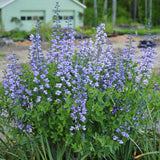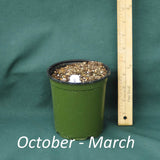Baptisia ‘Purple Smoke’ combines the best qualities of both its parents to produce a plant with beautiful, light purple flowers and finely textured leaves.
- Tough and long-lived
- Thrives in poor soil
- Deer resistant
Details
- 3 ft. tall and 4 ft. wide
- Rounded and shrub-like
- Clump-forming
- Hardy in USDA hardiness zones 5, 6, 7, 8, and 9
Flowering period
In central North Carolina, Purple Smoke False Indigo starts blooming at the end of April and continues for two to three weeks.
How to grow
Baptisia ‘Purple Smoke’ grows best in full sun and well-drained soil. Plants tend to get floppy and bloom poorly when cultivated in too much shade.
Care and maintenance
Easy to care for, just cut down old stems to the ground anytime during the winter.
Where to plant
Formal and informal gardens where it provides durability and seasonal color.
When to plant
The best time is during the growing season when plants are producing new roots.
When will my plant flower?
Flowering-size plants that will bloom their first year if purchased before mid-April.
Native habitat and range
The parents of Baptisia Purple Smoke (B. australis variety aberrans and B. alba) grow in open habitats. They are both rare-to-uncommon in scattered locations throughout the southeastern United States.
Source and origin
Plants are grown from cuttings at our nursery. The original plant was discovered growing at the North Carolina Botanical Gardens in a block of Baptisia australis var. aberrans plants that are used by the garden for collecting seeds.
| States | Orders up to $50 | Orders $51 to $100 | Orders over $100 |
| AL, DE, GA, KY, MD, NC, OH, PA, SC, TN, VA, and WV | $16 | $18 | $20 |
| AR, CT, FL, IL, IN, LA, MA, MI, MO, MS, NH, NJ, NY, RI, VT, and WI | $18 | $20 | $22 |
| IA, KS, ME, MN, OK, and TX | $20 | $22 | $24 |
| CO, NE, ND, and SD | $22 | $24 | $26 |
Sorry, we can't ship plants outside of the continental United States or to AK, AZ, CA, HI, ID, NM, NV, OR, UT, and WA due to agriculture restrictions.
When will my order be shipped?All plants are shipped within two weeks of placing an order.
Is it okay to plant in the winter?Yes, as long as the soil is not frozen. Planting native perennials in winter and early spring gives your plants a head start before the summer heat arrives.
What if it’s too cold to plant where I live, but I want to buy a plant before it sells out?Dormant plants can safely be kept in a basement, garage, or cool room until you are ready to plant in late winter or early spring.
How will my plants get delivered?Most orders are shipped on Monday or Tuesday via UPS Ground, which depending on the destination takes between 1 to 4 days.
Are your plants shipped in their containers?Yes, all our plants are shipped in their growing containers. The majority are grown in containers that are 4.5 inches wide by 5 inches deep and 32 fl. oz. / 946 ml in volume.
Do you guarantee your plants?We guarantee our plants to be healthy, ready for planting and correctly named. We are not able to guarantee whether a plant will grow in your garden as there are too many circumstances that are beyond our control.
On rare occasions, a plant shipped dormant may fail to emerge from its dormancy. If this happens, please let us know. If you are concerned about a plant, please contact us within 14 days to let us know. If we can’t help you make it grow, we’ll send you a new plant or issue a refund.
You can return your plants if you no longer want them once they arrive. To receive a refund (minus 20% restocking fee) the plants must be returned in good condition. Return shipping is the customer’s responsibility.
Can I cancel my order?Yes, you can cancel your order. Please visit our terms and service page for details.
What about sales tax?We propagate our own plants and are not required to collect North Carolina sales tax.
Where can I find information about your plants?Here are some FAQ on how we grow plants.












